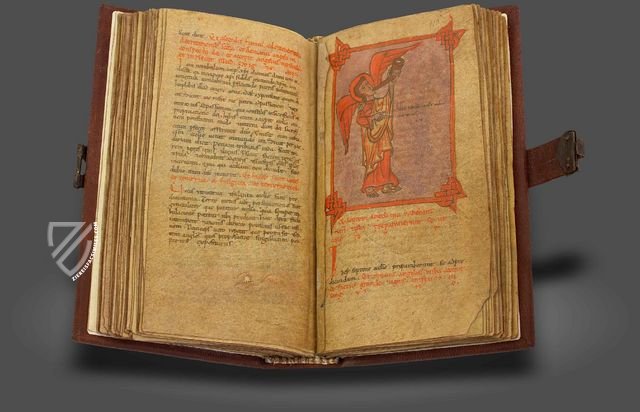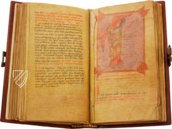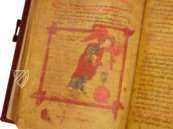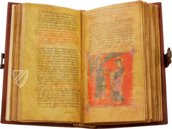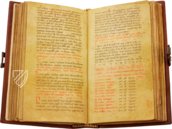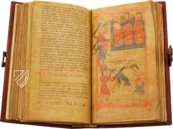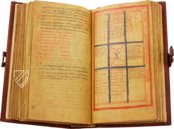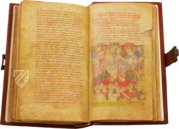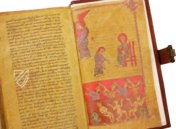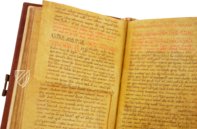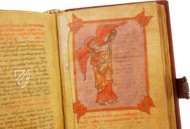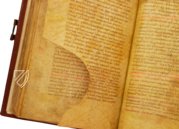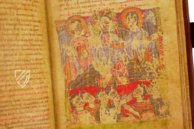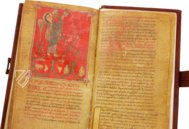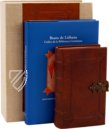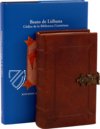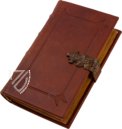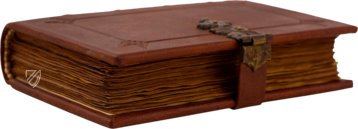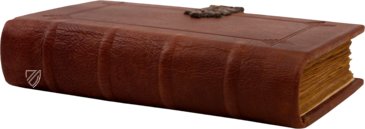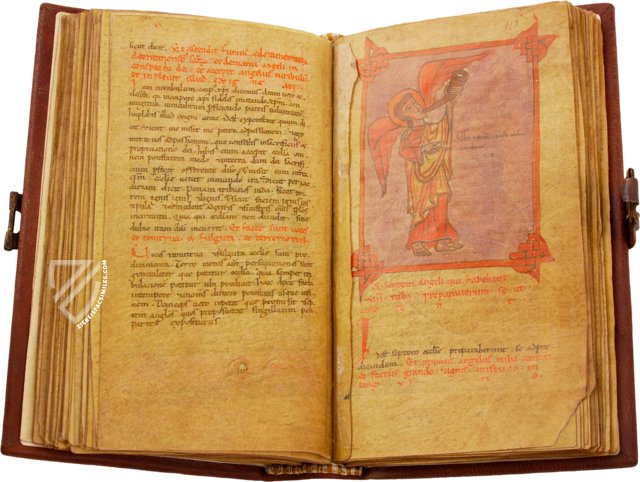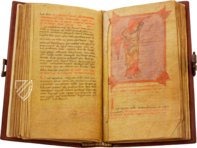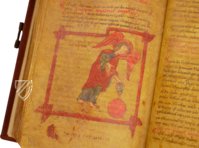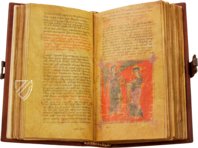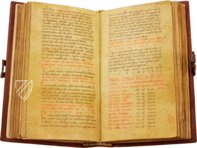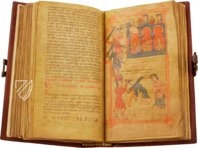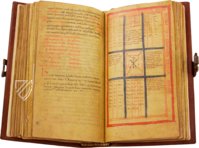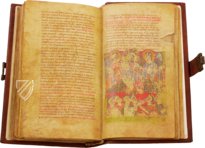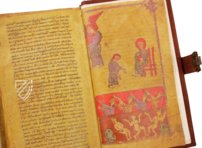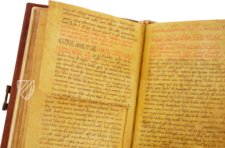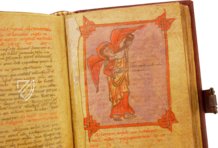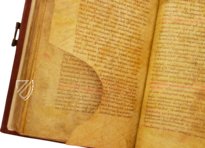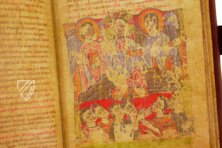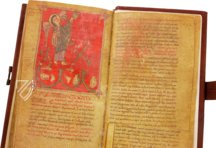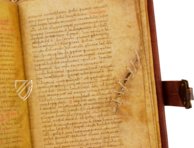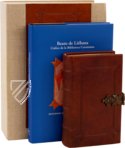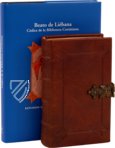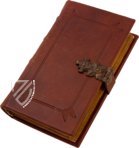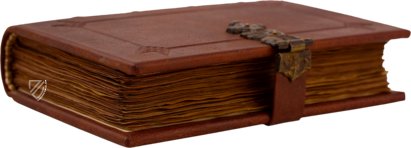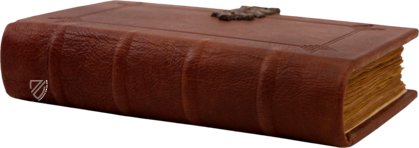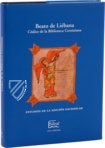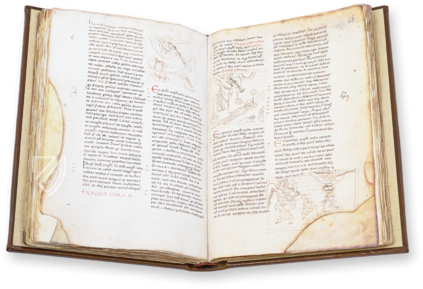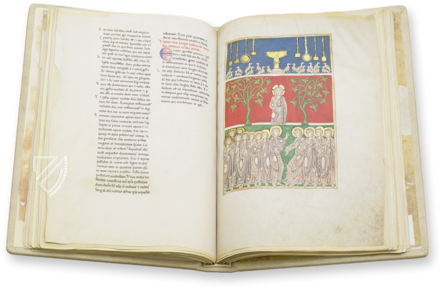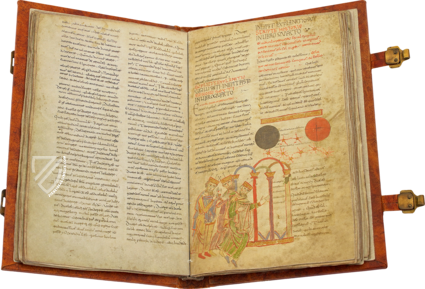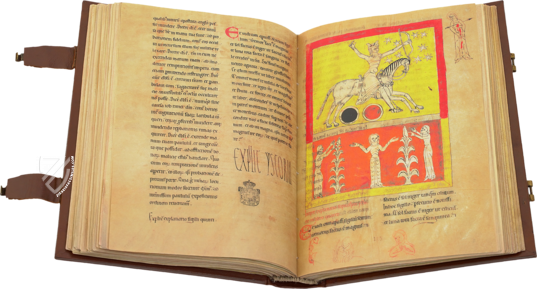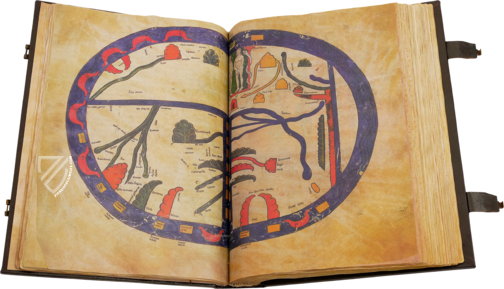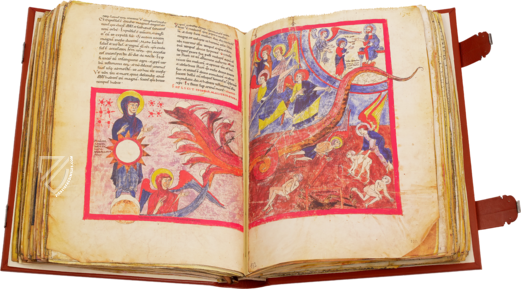Beatus of Liébana - Corsini Codex
(1,000€ - 3,000€)
The Corsini Codex has an exciting history of possession to tell that travels from Spain to Italy. The Beautus manuscript probably originates from the second half of the 12th century in the Sahagún Monastery in Spain. The remarkable Mozarabic style of the miniatures express themselves in the simple perfection of the depictions, which are set against a luminous orange colored background and are flamboyantly colored in some parts, incomplete in others. For this reason and through the discernable signs of usage, the checkered history and the practical application of the manuscript indicates that it was not only prized as a collectible, but also found regular use. As a result of this it is considered to be the most interesting of the 27 illustrated Beatus manuscripts that are known today.
Beatus of Liébana - Corsini Codex
The Corsini Codex has an exciting history of possession to tell, that travels from Spain to Italy. The Beautus manuscript probably originates from the second half of the 12th century in the Sahagún Monastery in Spain. The remarkable Mozarabic style of the miniatures express themselves in the simple perfection of the depictions, which are set against a luminous orange colored background and are flamboyantly colored in some parts, incomplete in others. For this reason and through the discernable signs of usage, the checkered history and the practical application of the manuscript indicates that it was not only prized as a collectible, but also found regular use. As a result of this it is considered to be the most interesting of the 27 illustrated Beatus manuscripts that are known today.
A Beatus as a Treasure
In an unusually small format for a Beatus Manuscript of 16.7 x 9.7 cm, the Corsini Codex collects the most-influential Apocalypse commentary by Beatus of Liébana with gorgeous miniatures. Altogether, 10 miniatures adorn the 243 pages of the manuscript. Not only do the miniatures have an archaic and primordial character to their style, but so does the manuscript as a whole. The script, sometimes written in red ink, is recorded in Carolingian miniscule with Gothic echoes.
Impressive Miniatures
In terms of pictorial adornment, some make mention of a table with symbolic and referential content that adorns the codex. However, others are to be mentioned, especially the mostly half-page miniatures that illustrated the text. Simple borders surround the luminous orange-colored backgrounds, against which the scenes play out. In terms of content, the pictures are concerned with the tales of John and the angel of the church of Sardis, of the Antichrist who destroys Jerusalem, of Christ in the clouds, or of the angels of the apocalypse. Not just the completed miniatures are interesting. Also the incomplete, unfinished drawings make the manuscript something special, allowing the codex’s process of formation to be understood.
The style of the manuscript’s illumination can be attributed to Spain. The paintings appear simple and withdrawn. The two-dimensionality of the figures and the absence of depictions of nature indicate the Mozarabic style. This finds its clearest expression in the Corsini Codex.
From Spain to Italy
The estimation of the Corsini Codex’s worth is not clear judging by the manuscript’s signs of use. Also its history of ownership impressively describes how the specialness of this Beatus manuscript was already always agreed upon. Under King Philip IV of Spain, the codex was pilfered from Sahagún by the Count of Olivares. The manuscript then came in to the possession of the writer and librarian Juan Lucas Cortés. The Italian Cardinal Francesco Acquaviva acquired the Beatus at the beginning of the 18th century and brought it from Spain to Italy. There it was acquired by Cardinal Bartolomeo Corsini in 1723, whose library composed cornerstone of the Biblioteca dell'Accademia Nazionale dei Lincei e Corsiniana in Rome.
Codicology
- Alternative Titles
- Beato de la Biblioteca Corsiniana
Beatus of Liebana from the Corsini Library
Beatus Corsiniana - Size / Format
- 342 pages / 16.7 × 9.7 cm
- Origin
- Spain
- Date
- 1151–1200
- Epochs
- Style
- Genre
- Language
- Illustrations
- 10 miniatures
- Artist / School
- Beatus of Liébana (died after 798) (author)
- Previous Owners
- Count Duke of Olivares
Lucas Juan Cortés
Cardinal Francesco Acquaviva
Cardinal Bartolomeo Corsini
Beatus of Liébana - Corsini Codex
Unfinished Lamb of God
With one large eye, holding its iconic cross-staff, and adorned by the cross-halo normally reserved for Christ and God the Father, this incomplete miniature depicts the Lamb of God, which is one of the most prominent figures in the Book of Revelation. However, what scene is supposed to be depicted here cannot be discerned because the miniature is incomplete. Even the frame just seems to end as though the artist was interrupted by someone or something and then simply forgot to finish it.
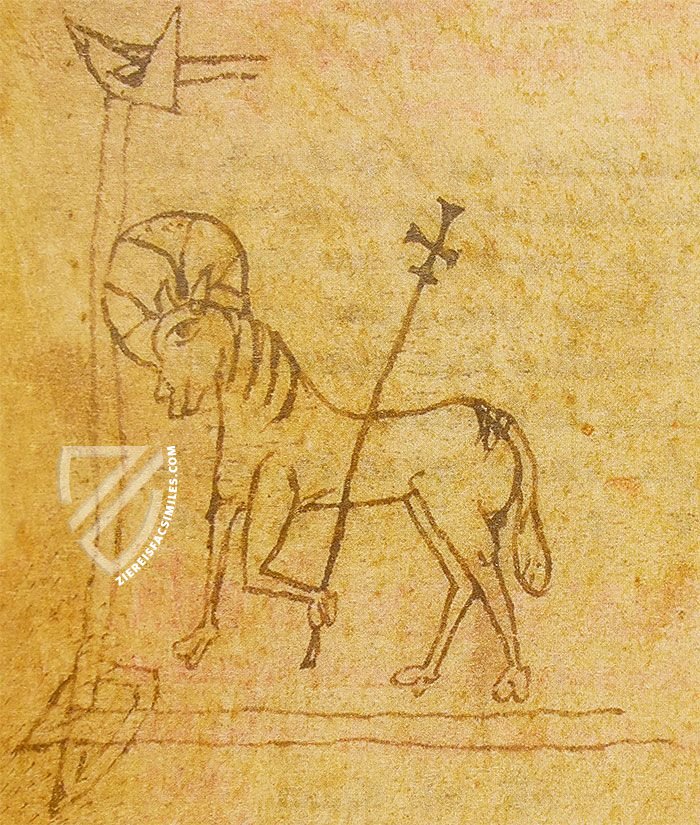
Beatus of Liébana - Corsini Codex
The Two Witnesses Killed by the Antichrist
Revelation 11 describes the “two witnesses” clothed in sackcloth who will prophesy for 1,260 days and to whom power is given by God to stop the rain, turn waters into blood, and unleash plagues upon the earth. This naturally does not make them popular and when they are killed by the Beast, the people celebrate for three and a half days, leaving their bodies unburied.
They are then resurrected by God, striking great fear into those that saw them, and they then ascend into heaven in the sight of their enemies. The two witnesses are depicted here being dragged by their hair out of a building with distinctive Moorish horseshoe arches. One is then brought to the foreground where his throat is slit by a man wearing a strange square hat.
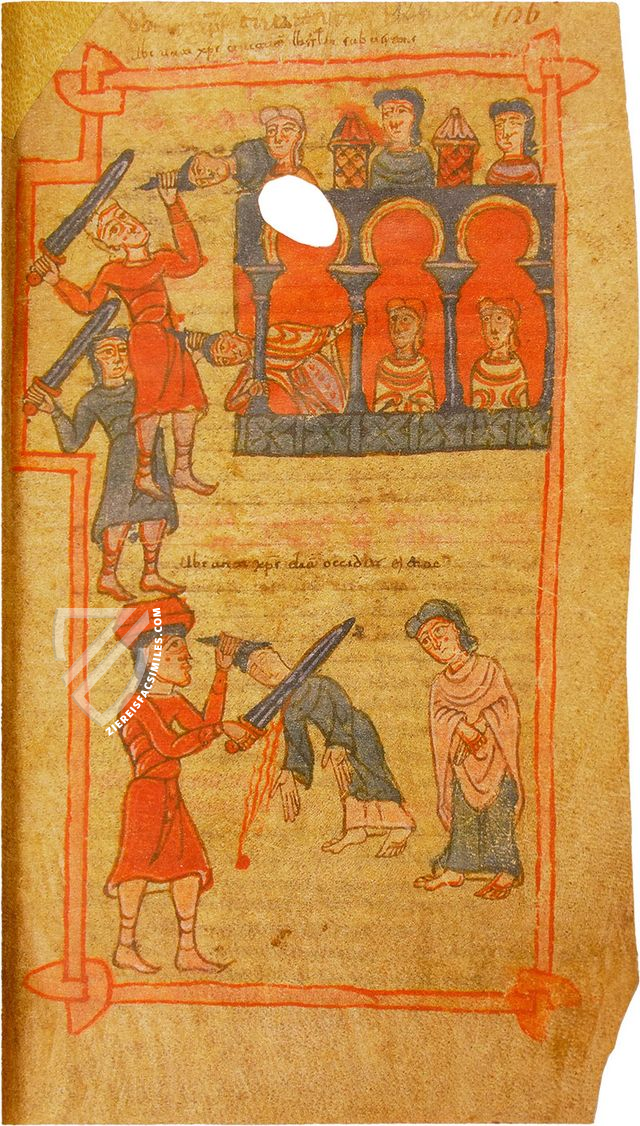
#1 Beato de la Biblioteca Corsiniana
Language: Spanish
(1,000€ - 3,000€)
- Treatises / Secular Books
- Apocalypses / Beatus
- Astronomy / Astrology
- Bestiaries
- Bibles / Gospels
- Chronicles / History / Law
- Geography / Maps
- Saints' Lives
- Islam / Oriental
- Judaism / Hebrew
- Single Leaf Collections
- Leonardo da Vinci
- Literature / Poetry
- Liturgical Manuscripts
- Medicine / Botany / Alchemy
- Music
- Mythology / Prophecies
- Psalters
- Other Religious Books
- Games / Hunting
- Private Devotion Books
- Other Genres
- Afghanistan
- Armenia
- Austria
- Belgium
- Belize
- Bosnia and Herzegovina
- China
- Colombia
- Costa Rica
- Croatia
- Cyprus
- Czech Republic
- Denmark
- Egypt
- El Salvador
- Ethiopia
- France
- Germany
- Greece
- Guatemala
- Honduras
- Hungary
- India
- Iran
- Iraq
- Israel
- Italy
- Japan
- Jordan
- Kazakhstan
- Kyrgyzstan
- Lebanon
- Liechtenstein
- Luxembourg
- Mexico
- Morocco
- Netherlands
- Palestine
- Panama
- Peru
- Poland
- Portugal
- Romania
- Russia
- Serbia
- Spain
- Sri Lanka
- Sweden
- Switzerland
- Syria
- Tajikistan
- Turkey
- Turkmenistan
- Ukraine
- United Kingdom
- United States
- Uzbekistan
- Vatican City
- A. Oosthoek, van Holkema & Warendorf
- Aboca Museum
- Ajuntament de Valencia
- Akademie Verlag
- Akademische Druck- u. Verlagsanstalt (ADEVA)
- Aldo Ausilio Editore - Bottega d’Erasmo
- Alecto Historical Editions
- Alkuin Verlag
- Almqvist & Wiksell
- Amilcare Pizzi
- Andreas & Andreas Verlagsbuchhandlung
- Archa 90
- Archiv Verlag
- Archivi Edizioni
- Arnold Verlag
- ARS
- Ars Magna
- ArtCodex
- AyN Ediciones
- Azimuth Editions
- Badenia Verlag
- Bärenreiter-Verlag
- Belser Verlag
- Belser Verlag / WK Wertkontor
- Benziger Verlag
- Bernardinum Wydawnictwo
- BiblioGemma
- Biblioteca Apostolica Vaticana (Vaticanstadt, Vaticanstadt)
- Bibliotheca Palatina Faksimile Verlag
- Bibliotheca Rara
- Boydell & Brewer
- Bramante Edizioni
- Bredius Genootschap
- Brepols Publishers
- British Library
- C. Weckesser
- Caixa Catalunya
- Canesi
- CAPSA, Ars Scriptoria
- Caratzas Brothers, Publishers
- Carus Verlag
- Casamassima Libri
- Centrum Cartographie Verlag GmbH
- Chavane Verlag
- Christian Brandstätter Verlag
- Circulo Cientifico
- Club Bibliófilo Versol
- Club du Livre
- CM Editores
- Collegium Graphicum
- Collezione Apocrifa Da Vinci
- Comissão Nacional para as Comemorações dos Descobrimentos Portugueses
- Coron Verlag
- Corvina
- CTHS
- D. S. Brewer
- Damon
- De Agostini/UTET
- De Nederlandsche Boekhandel
- De Schutter
- Deuschle & Stemmle
- Deutscher Verlag für Kunstwissenschaft
- DIAMM
- Droz
- E. Schreiber Graphische Kunstanstalten
- Ediciones Boreal
- Ediciones Grial
- Ediclube
- Edições Inapa
- Edilan
- Editalia
- Edition Deuschle
- Edition Georg Popp
- Edition Leipzig
- Edition Libri Illustri
- Editiones Reales Sitios S. L.
- Éditions de l'Oiseau Lyre
- Editions Medicina Rara
- Editorial Casariego
- Editorial Mintzoa
- Editrice Antenore
- Editrice Velar
- Edizioni Edison
- Egeria, S.L.
- Eikon Editores
- Electa
- Emery Walker Limited
- Enciclopèdia Catalana
- Eos-Verlag
- Ephesus Publishing
- Ernst Battenberg
- Eugrammia Press
- Extraordinary Editions
- Fackelverlag
- Facsimila Art & Edition
- Facsimile Editions Ltd.
- Facsimilia Art & Edition Ebert KG
- Faksimile Verlag
- Feuermann Verlag
- Folger Shakespeare Library
- Franco Cosimo Panini Editore
- Friedrich Wittig Verlag
- Fundación Hullera Vasco-Leonesa
- G. Braziller
- Gabriele Mazzotta Editore
- Gebr. Mann Verlag
- Gesellschaft für graphische Industrie
- Getty Research Institute
- Giovanni Domenico de Rossi
- Giunti Editore
- Graffiti
- Grafica European Center of Fine Arts
- Guido Pressler
- Guillermo Blazquez
- Gustav Kiepenheuer
- H. N. Abrams
- Harrassowitz
- Harvard University Press
- Helikon
- Hendrickson Publishers
- Henning Oppermann
- Herder Verlag
- Hes & De Graaf Publishers
- Hoepli
- Holbein-Verlag
- Houghton Library
- Hugo Schmidt Verlag
- Idion Verlag
- Il Bulino, edizioni d'arte
- ILte
- Imago
- Insel Verlag
- Insel-Verlag Anton Kippenberger
- Instituto de Estudios Altoaragoneses
- Instituto Nacional de Antropología e Historia
- Introligatornia Budnik Jerzy
- Istituto dell'Enciclopedia Italiana - Treccani
- Istituto Ellenico di Studi Bizantini e Postbizantini
- Istituto Geografico De Agostini
- Istituto Poligrafico e Zecca dello Stato
- Italarte Art Establishments
- Jan Thorbecke Verlag
- Johnson Reprint Corporation
- Josef Stocker
- Josef Stocker-Schmid
- Jugoslavija
- Karl W. Hiersemann
- Kasper Straube
- Kaydeda Ediciones
- Kindler Verlag / Coron Verlag
- Kodansha International Ltd.
- Konrad Kölbl Verlag
- Kurt Wolff Verlag
- La Liberia dello Stato
- La Linea Editrice
- La Meta Editore
- Lambert Schneider
- Landeskreditbank Baden-Württemberg
- Leo S. Olschki
- Les Incunables
- Liber Artis
- Library of Congress
- Libreria Musicale Italiana
- Lichtdruck
- Lito Immagine Editore
- Lumen Artis
- Lund Humphries
- M. Moleiro Editor
- Maison des Sciences de l'homme et de la société de Poitiers
- Manuscriptum
- Martinus Nijhoff
- Maruzen-Yushodo Co. Ltd.
- MASA
- Massada Publishers
- McGraw-Hill
- Metropolitan Museum of Art
- Militos
- Millennium Liber
- Müller & Schindler
- Nahar - Stavit
- Nahar and Steimatzky
- National Library of Wales
- Neri Pozza
- Nova Charta
- Oceanum Verlag
- Odeon
- Orbis Mediaevalis
- Orbis Pictus
- Österreichische Staatsdruckerei
- Oxford University Press
- Pageant Books
- Parzellers Buchverlag
- Patrimonio Ediciones
- Pattloch Verlag
- PIAF
- Pieper Verlag
- Plon-Nourrit et cie
- Poligrafiche Bolis
- Presses Universitaires de Strasbourg
- Prestel Verlag
- Princeton University Press
- Prisma Verlag
- Priuli & Verlucca, editori
- Pro Sport Verlag
- Propyläen Verlag
- Pytheas Books
- Quaternio Verlag Luzern
- Reales Sitios
- Recht-Verlag
- Reichert Verlag
- Reichsdruckerei
- Reprint Verlag
- Riehn & Reusch
- Roberto Vattori Editore
- Rosenkilde and Bagger
- Roxburghe Club
- Salerno Editrice
- Saltellus Press
- Sandoz
- Sarajevo Svjetlost
- Schöck ArtPrint Kft.
- Schulsinger Brothers
- Scolar Press
- Scrinium
- Scripta Maneant
- Scriptorium
- Shazar
- Siloé, arte y bibliofilia
- SISMEL - Edizioni del Galluzzo
- Sociedad Mexicana de Antropología
- Société des Bibliophiles & Iconophiles de Belgique
- Soncin Publishing
- Sorli Ediciones
- Stainer and Bell
- Studer
- Styria Verlag
- Sumptibus Pragopress
- Szegedi Tudomànyegyetem
- Taberna Libraria
- Tarshish Books
- Taschen
- Tempus Libri
- Testimonio Compañía Editorial
- Thames and Hudson
- The Clear Vue Publishing Partnership Limited
- The Facsimile Codex
- The Folio Society
- The Marquess of Normanby
- The Richard III and Yorkist History Trust
- Tip.Le.Co
- TouchArt
- TREC Publishing House
- TRI Publishing Co.
- Trident Editore
- Tuliba Collection
- Typis Regiae Officinae Polygraphicae
- Union Verlag Berlin
- Universidad de Granada
- University of California Press
- University of Chicago Press
- Urs Graf
- Vallecchi
- Van Wijnen
- VCH, Acta Humaniora
- VDI Verlag
- VEB Deutscher Verlag für Musik
- Verlag Anton Pustet / Andreas Verlag
- Verlag Bibliophile Drucke Josef Stocker
- Verlag der Münchner Drucke
- Verlag für Regionalgeschichte
- Verlag Styria
- Vicent Garcia Editores
- W. Turnowski Ltd.
- W. Turnowsky
- Waanders Printers
- Wiener Mechitharisten-Congregation (Wien, Österreich)
- Wissenschaftliche Buchgesellschaft
- Wissenschaftliche Verlagsgesellschaft
- Wydawnictwo Dolnoslaskie
- Xuntanza Editorial
- Zakład Narodowy
- Zollikofer AG

